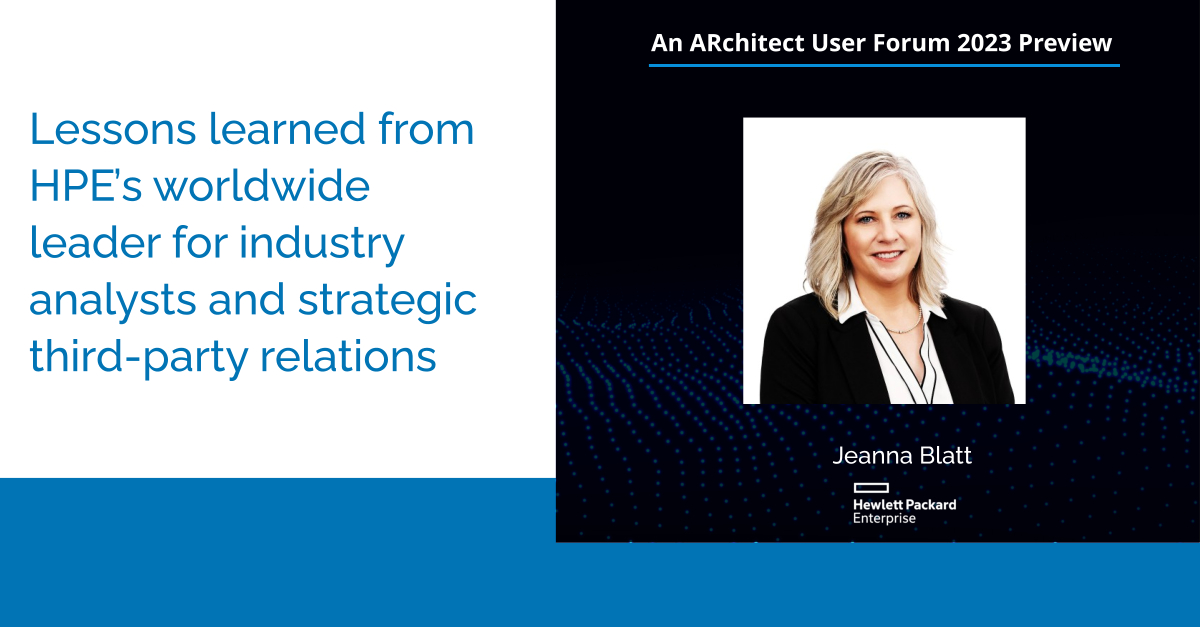During his time at Gartner — spanning a career as a research analyst and executive advisor for more than 10 years — Julian Tirsu interacted with analyst relations (AR) professionals on a near-daily basis. Now he’s an AR pro himself!
Julian’s background comes in handy as he leads analyst relations at Egnyte, functioning as a one-person AR team. In Part II of our “Profile in AR” with Julian, he shares the inside scoop on working with Gartner: with tips for using Gartner Peer Insights to your advantage, improving your positioning in a Magic Quadrant, steering clear of analyst pet peeves and more. We think you’ll enjoy and appreciate these helpful insights!
(If you missed Part I of the conversation last week, you can check it out here – with details on Julian’s career journey from analyst to analyst relations, what surprised him about the transition and more.)
Q: When you were an analyst, what did AR professionals do that impressed you?
Julian: The were many behaviors I saw that I knew were best practices — one of the most important was showing up early to a briefing or inquiry. That way, when the analyst gets on, there’s someone there to greet them. Being late just detracts from the valuable time you have.
Analysts understand that things come up, of course, but you want to strive to be on time or early, with everyone on from your side — and if presenting, your deck should also be locked and loaded. That way, when the analyst joins, it’s just a quick round of intros, and you’re ready to go without wasting time.
As an analyst, I was also impressed when vendors had no technical glitches during an inquiry or briefing. This showed me that you were prepared, you had the right software downloaded on your machine, you did a test to make sure everything was running correctly, and that this meeting is important to you.
And then having a structured agenda is key: “This is what we’re presenting to you.” If applicable, it’s also useful to provide a refresher: “This is what we shared or talked about last time.” These are always good to have — because even though I took meticulous notes, not every analyst is as diligent. And since analysts talk to many different vendors and end-users on a daily basis, it’s good to provide context for your conversation, rather than relying on the analyst’s memory.
And if you have collateral to share, send it either as a follow-up or a precursor. I’ve seen it done both ways. You obviously don’t want to inundate analysts, as they get their fair share of emails, but maybe a few days before your call, you send them the deck. And then after the conversation, follow up with something like: “It was great to meet you. Here are the case studies/takeaways/links/etc. you requested…” This helps keep the interaction flowing into the next one.
Finally, as you take in information from the analysts, you should share, process and roll it up in a way that helps build your AR strategy.
Q: On the flip side, when you were an analyst, did you have any pet peeves when working with AR pros? What are some behaviors to avoid?
Julian: One pet peeve was canceling the day of the inquiry or briefing. For inquiries, in particular, there’s a lot we do as analysts to prepare: We look into the vendor, we visit their website, we look at research about them, we go back through previous conversations, we tap our peers: “What you have heard about this vendor?” and “Is there a deck you’ve seen from them before?”
Since we’ve likely prepped the previous day or even a couple of days beforehand, canceling inquiries further in advance is helpful with regard to time management for the analyst.
Another pet peeve was the vendor not having a deck when presenting on a briefing. I attended several briefings where the vendor just wanted to chit-chat about their solution. That’s typically not how vendor briefings are run at Gartner or at other research firms either. Not having a deck was also off-putting for me because you don’t have anything to take with you to glance back at and reference. There are only so many notes you can take during a presentation, right?
Here’s the final pet peeve that I had: There were many times when a company put the “wrong” individuals on an inquiry. A lot of interactions usually have a combination of product marketing and an executive on the vendor side. But you run into problems when it’s just marketing on the line — especially when they don’t understand the scope of the meeting, or they try to sell you that their product is the best product you’ve ever seen.
As an analyst, you’re often trying to get information on a company and why they might be a good fit within the context of your research agenda. And if the vendor falls within your coverage area, you should be getting factual information about them, not necessarily the “Let us show you why we’re the best!” story. You want to hear more about what the vendor is trying to solve for customers and how they’re tackling certain use cases.
Q: AR pros today often have questions about Gartner Peer Insights and AR’s involvement. Based on your experiences, can you share tips for vendors navigating this?
Julian: That’s an interesting question. I have significant experience with Gartner Peer Insights since it was part of the research process when writing Magic Quadrants or Market Guides. Many AR professionals would ask about Peer Insights in this context as well. As far as how much AR should be involved — it depends, as a true analyst would say. For me at Egnyte, Peer Insights — along with G2, Capterra, TrustRadius and others — is typically handled by our Customer Success team.
But as an analyst relations professional, even if you’re not directly involved in Peer Insights, it’s still important to be aware of it and how you can use the reviews to your advantage. For example, as an analyst, I saw AR pros and their companies use Peer Insights to change the narrative if they were positioned as a Niche Player or a Visionary in a Magic Quadrant. If the organization had done enough marketing and awareness campaigns to drive reviews on Peer Insights (e.g., “If you love us, please let us know and leave a review…”), AR and marketing pros could lead the messaging charge. They might position it like: “Yes, we placed as a Niche Vendor. And these are the things we’re working on for the future.” Or “We placed this way because we primarily focus on these specific use cases that the rest of the market doesn’t address. And it’s what we do really well. But don’t just take it from us: Look on Peer Insights for information about how great we are in those segments!”
So, when companies have favorable Peer Insights ratings, I’ve seen those approaches work really well — especially when salespeople have to answer questions like: “Gartner isn’t rating you as a Leader. Why is that?” And of course, being placed as a Niche Vendor or a Visionary isn’t the end of the world, but by using Peer Insights, you can certainly tell a better story.
Q: Can you share any advice for AR pros who are looking to help companies improve their placement in Magic Quadrants?
Julian: That’s a great question. If it’s an existing Magic Quadrant — and this wouldn’t be applicable for a new one — pay very close attention to the cautions. The strengths are something you can probably manage on a yearly basis. But the cautions are where, I think, some of the greatest impact can be had, especially if you start improving at a good cadence.
So, if you’re having conversations on a regular basis with the analyst(s) who wrote the Magic Quadrant — and your briefings are tailored to showcase the specific changes you’ve made based on the cautions, how you’ve taken their advice, how you’ve adjusted marketing messaging, etc. — then the analyst will see that you acknowledge what they’re saying and that you understand what’s missing and are making great strides to improve.
All of this should be done, of course, in the context of the inclusion and exclusion criteria. And then you’ll want to review how the product or platform gets weighted, by specifically looking at the peer companion document, the Critical Capabilities. You can get an idea of what may be important for the Magic Quadrant itself — even though that’s a vendor evaluation, rather than a product one.
So those are the three things I think are very much important to focus on at the end of the day: the cautions, the inclusion and exclusion criteria, and the weightings within the Critical Capabilities document. A lot of established AR folks may think these insights are a given, but it’s a tried-and-true process if you are methodical about it. Many up-and-coming vendors that are successful pay close attention to these things.
Q: Do you have any predictions on the future of AR?
I can see that AR as a practice is still in its infancy. Many AR programs with smaller teams do not yet have a mold that fits them. And there are nuances to each program that cannot be foreseen. However, I do see that most new vendors also want a formal analyst relations program and team to build and manage AR in-house. So inevitably, AR will become a standard practice for all new vendors, alongside marketing and communications, as yet another tool in the vendor’s toolbox.
Q: Finally, do you have any hobbies you’d like to share?
Julian: I have a lot of hobbies… many of which were more feasible pre-COVID and pre-baby! My wife and I are enjoying being new parents; we have a 20-month-old girl at home.
Some of my favorite hobbies are hiking and camping; we can do this year-round. And I like skiing in the winter and cycling in the spring-to-fall months. We enjoy traveling too, which is often more by car these days.
I’m also a lifelong gamer. I especially like strategy and third-person adventure games. You can usually find me playing something from my favorite game series: Assassin’s Creed, Elder Scrolls, Halo, Mass Effect, and The Witcher.
***
Many thanks to Julian for these great insights and the “inside scoop”! If you want to reach Julian, you can connect with him on LinkedIn.
And stay tuned for additional Profiles in AR!
###




